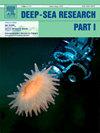First quantitative assessment of deep-sea acorn worm (Enteropneusta) in PMN-rich zones of the Central Indian Ocean Basin
IF 2.1
3区 地球科学
Q2 OCEANOGRAPHY
Deep-Sea Research Part I-Oceanographic Research Papers
Pub Date : 2025-07-30
DOI:10.1016/j.dsr.2025.104560
引用次数: 0
Abstract
The deep-sea harbors a diverse array of organisms playing crucial roles in the ecosystem yet remains largely unexplored. Enteropneusta, commonly known as acorn worms, are a key component of the deep-sea benthos as they play a major role in surficial bioturbation and nutrient cycling. However, knowledge about their distribution, abundance, and behavior in these profound depths is scarce. This study provides the first quantitative assessment of enteropneusta (acorn worms) in the Central Indian Ocean Basin at depths greater than 5200 m. The data were collected using high-resolution seafloor imagery captured by an Autonomous Underwater Vehicle (AUV), which is pre-programmed to carry out surveys independently—unlike Remotely Operated Vehicles (ROVs), which require continuous control by operators aboard the surface vessel. In this study the AUV analyzed an area of 0.5 km2, revealing 2955 enteropneust fecal trails and 13 acorn worms (12 Tergivelum sp. and single Allapasus sp.). The study examined trail characteristics, including shapes, area coverage, and quality, as well as acorn worm morphology. Spiral trails dominated, with no significant preference for rotational direction. Trail quality was ranked from 1° to 3°, with most trails being 2° and 3° quality. This pioneering work provides crucial insights into deep-sea ecosystem functioning in the region, informing responsible decision-making regarding potential PMN exploration activities. This report also a first kind of its quantitative approach of enteropneusta among all the potential PMN sites in the global ocean. The findings contribute to our understanding of deep-sea biodiversity and ecological dynamics in the Indian Ocean.
中印度洋盆地富pmn区深海橡子虫(Enteropneusta)的首次定量评价
深海孕育着各种各样的生物,在生态系统中扮演着至关重要的角色,但大部分仍未被探索。Enteropneusta,俗称橡子虫,是深海底栖动物的重要组成部分,在表层生物扰动和养分循环中起着重要作用。然而,关于它们在深海中的分布、数量和行为的知识却很少。本研究首次对印度洋中部盆地深度大于5200 m的橡子虫进行了定量评估。这些数据是使用自主水下航行器(AUV)捕获的高分辨率海底图像收集的,AUV是预先编程的,可以独立进行调查,而不像遥控航行器(rov)需要操作员在水面船只上连续控制。在本研究中,AUV分析了0.5 km2的区域,发现了2955条企业粪便痕迹和13条橡实蠕虫(12条Tergivelum sp.和1条Allapasus sp.)。该研究检查了痕迹特征,包括形状、面积覆盖和质量,以及橡子蠕虫的形态。螺旋尾迹占主导地位,没有明显的旋转方向偏好。步道质量从1°到3°排序,大多数步道为2°和3°质量。这项开创性的工作提供了对该地区深海生态系统功能的重要见解,为潜在PMN勘探活动的负责任决策提供了信息。在全球海洋中所有潜在的PMN站点中,本报告也首次对其进行了定量分析。这些发现有助于我们了解印度洋的深海生物多样性和生态动态。
本文章由计算机程序翻译,如有差异,请以英文原文为准。
求助全文
约1分钟内获得全文
求助全文
来源期刊
CiteScore
4.60
自引率
4.20%
发文量
144
审稿时长
18.3 weeks
期刊介绍:
Deep-Sea Research Part I: Oceanographic Research Papers is devoted to the publication of the results of original scientific research, including theoretical work of evident oceanographic applicability; and the solution of instrumental or methodological problems with evidence of successful use. The journal is distinguished by its interdisciplinary nature and its breadth, covering the geological, physical, chemical and biological aspects of the ocean and its boundaries with the sea floor and the atmosphere. In addition to regular "Research Papers" and "Instruments and Methods" papers, briefer communications may be published as "Notes". Supplemental matter, such as extensive data tables or graphs and multimedia content, may be published as electronic appendices.

 求助内容:
求助内容: 应助结果提醒方式:
应助结果提醒方式:


